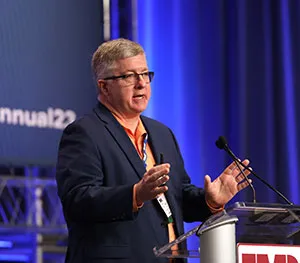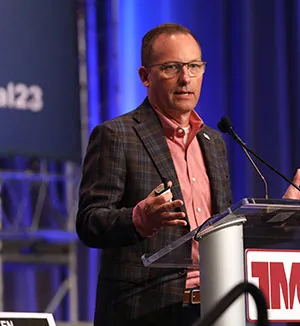Managing Editor, Features and Multimedia
Fleets Will Need to Navigate Powertrain Options Amid Green Push

[Stay on top of transportation news: Get TTNews in your inbox.]
ORLANDO, Fla. — Fleet operators will have an array of truck powertrain choices to consider in the future as the industry complies with stricter emissions regulations and meets shippers’ demands for more environmentally sustainable freight transportation.
Along with cleaner diesel engines, trucking companies will have the option of deploying zero-emission vehicles such as battery-electric and hydrogen fuel cell electric trucks, as well as vehicles with internal combustion engines powered by natural gas, hydrogen, biofuels and renewable diesel.
Fleet executives and industry suppliers discussed those expanding powertrain options during a Feb. 28 technical session here at the Technology & Maintenance Council’s Annual Meeting and Transportation Technology Exhibition.
“There is no silver bullet. We have a lot of applications in this industry to consider,” said Ken Marko, senior manager for fleet sustainability at US Foods.
The Rosemont, Ill.-based food service distributor ranks No. 4 on the Transport Topics Top 100 list of the largest private carriers in North America.
Major truckload carrier Schneider is tackling the sustainability challenge through a combination of operational improvements, a shift toward more intermodal freight and investments in more efficient vehicle technologies.

“There is no silver bullet. We have a lot of applications in this industry to consider,” Marko says. (John Sommers II for Transport Topics)
“Our customers have made sustainability a priority, thus as one of their suppliers we’d better do so as well,” said Robert Reich, Schneider’s executive vice president and chief administrative officer. “If it’s important to the customers, it’s got to be important to us.”
Schneider’s own sustainability goals, set in 2020, include a 7.5% reduction in carbon emissions per mile by 2025, doubling the size of its intermodal business by 2030 to drive emission reductions and reducing carbon emissions per mile by 60% by 2035.
“Our assumption is in order to hit that 60%, our fleet is going to look quite different — a lot of alternative power, a lot of electric vehicles in that future,” Reich said.
Schneider already is moving in that direction by deploying 90 battery-electric Freightliner eCascadia tractors in its Southern California intermodal operations.
Reich cautioned that rolling out its electric fleet has taken longer than the company originally anticipated due to delays on the part of its electric power company.
“Think about those utilities even before you’re thinking about what your truck solution might be,” he said.
Schneider is exploring other alternative power sources as well.
“I think natural gas is making a comeback,” Reich said.

Reich speaks to the crowd. (John Sommers II for Transport Topics)
The company plans to begin testing a fuel cell electric truck and also is looking at renewable diesel as a potential way to support shippers’ sustainability goals, he added. “Three years from now I think we’ve got all of this in the fleet.”
Schneider, based in Green Bay, Wis., ranks No. 8 on the Transport Topics Top 100 list of the largest for-hire carriers in North America.
Beverage and snack food giant PepsiCo Inc., which has set an aggressive goal to achieve net-zero emissions by 2040, has deployed a wide range of vehicle technologies in its own private fleet operations, including renewable diesel, renewable natural gas and battery-electric vehicles.
“There are several different technologies. Our goal is to leverage the best technology for the duty cycle and act sooner rather than later,” said Adam Buttgenbach, PepsiCo’s director of fleet engineering and sustainability.
Using a combination of low- and zero-emission technologies, the company has reduced greenhouse gas emissions by more than 90% at its facility in Modesto, Calif.
“We’ll use this as a template moving forward for future decarbonization,” Buttgenbach said.
PepsiCo, based in Purchase, N.Y., ranks No. 1 on the TT100 list of private carriers.
Engine and component supplier Cummins Inc. is pursuing a variety of technologies to reach its goal of zero emissions by 2050.
“To hit our targets, we have to lower our emissions today,” said Mark Ulrich, director of customer support.
That starts with properly spec’ing diesel trucks for maximum fuel efficiency, he said.
Looking forward, Cummins is developing more advanced diesel engines while investing in hydrogen combustion and fuel-agnostic engine platforms.
“We think there’s a long runway for internal combustion engine technology,” Ulrich said.

Roeth speaks during the session. (John Sommers II for Transport Topics)
At the same time, Cummins also is investing in new powertrain choices, including battery-electric and fuel cell systems.
“We think it’s critical that we provide fleets with options,” Ulrich said.
In the coming years, regulations from the U.S. Environmental Protection Agency and California’s Air Resources Board will require further reductions in nitrogen oxide and greenhouse gas emissions from commercial trucks and engines.
Technologies that could enable future truck engines to meet low NOx standards include cylinder deactivation and additional selective catalytic reduction, said Ameya Joshi, director of emerging technologies, regulations and electrification at industry supplier Corning Inc.
“The aftertreatment systems are getting more complex to solve this challenge,” he said.
In addition to engine efficiency improvements, the industry also will need to pursue electrification and low-carbon and renewable fuels.
“We need to keep working on all of these technologies if we’re going to effectively decarbonize the transportation sector,” Joshi said.
Want more news? Listen to today's daily briefing above or go here for more info
Mike Roeth, executive director at the North American Council for Freight Efficiency, encouraged fleets to begin planning for the future now.
“We really do suggest that now is the time for action around decarbonizing freight movement,” he said.
Roeth also said industry stakeholders should help fleets make the right powertrain decisions for their specific freight operations rather than pushing technologies that are not the right fit.
NACFE Releases Messy Middle Report: The messy middle is a time for action.
Red more here: https://t.co/6lQtrmicun#messymiddle #decarbonization #zeroemissions pic.twitter.com/52xTLJV8EQ — North American Council for Freight Efficiency (@NACFE_Freight) February 26, 2023
“With a lot of options, it’s easy to make a mistake,” he said. “This is not a time for that.”
A few days earlier, NACFE released a report evaluating the multiple powertrain options that will be available as the trucking industry transitions from diesel-powered trucks toward zero-emission transportation.


&uuid=(email))
